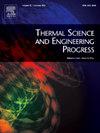Numerical simulation research on downhole methane combustion heating tool for hydrate exploitation: Gas−liquid heat transfer performance
IF 5.1
3区 工程技术
Q2 ENERGY & FUELS
引用次数: 0
Abstract
Natural gas hydrates are considered a promising clean energy resource with significant development potential. This study focuses on the research and application of energy supplementation tools in natural gas hydrate extraction. First, a methane combustion heating process is proposed, and a methane combustion heating tool is designed to heat hydrate reservoirs through methane combustion. The tool includes key components such as a pressure-bearing pipe and an igniter, with the primary goal of promoting hydrate dissociation by increasing the reservoir temperature. To assess the tool’s ignition and heating capabilities in a water-immersed environment, surface experiments are conducted, and the tool’s actual value for reservoir development is verified using a gas production model. Next, a flow field model of the tool in the downhole environment is established using Computational Fluid Dynamics (CFD), and the flow field characteristics and heat transfer performance of the tool are systematically studied. The results show that the tool can increase the reservoir temperature by 10 °C. Further analysis of the impact of various operational parameters on the internal flow field and heating efficiency reveals that a higher inlet gas flow rate (methane at 6 m/s) and optimized gas ratio (e.g., 1:5) significantly improve heating efficiency. Additionally, the influence of key structural parameters, such as the number of combustion ports and combustion channel dimensions, on the tool’s heating performance is analyzed. Based on these findings, recommendations for optimizing the tool’s design are proposed.
水合物开采用井下甲烷燃烧加热工具的数值模拟研究:气液传热性能
天然气水合物被认为是一种极具发展潜力的清洁能源。本研究的重点是能量补充工具在天然气水合物提取中的研究与应用。首先,提出了甲烷燃烧加热工艺,设计了甲烷燃烧加热工具,通过甲烷燃烧对水合物储层进行加热。该工具包括承压管和点火器等关键部件,主要目的是通过提高储层温度来促进水合物解离。为了评估该工具在水浸环境下的点火和加热能力,进行了地面实验,并通过产气模型验证了该工具对油藏开发的实际价值。其次,利用计算流体动力学(CFD)建立了该工具在井下环境下的流场模型,系统研究了该工具的流场特性和换热性能。结果表明,该工具可使储层温度提高10℃。进一步分析各工况参数对内部流场和热效率的影响,发现较高的进口气体流速(6 m/s的甲烷)和优化后的气体比(如1:5)显著提高了热效率。此外,还分析了燃烧口数量、燃烧通道尺寸等关键结构参数对刀具加热性能的影响。基于这些发现,提出了优化工具设计的建议。
本文章由计算机程序翻译,如有差异,请以英文原文为准。
求助全文
约1分钟内获得全文
求助全文
来源期刊

Thermal Science and Engineering Progress
Chemical Engineering-Fluid Flow and Transfer Processes
CiteScore
7.20
自引率
10.40%
发文量
327
审稿时长
41 days
期刊介绍:
Thermal Science and Engineering Progress (TSEP) publishes original, high-quality research articles that span activities ranging from fundamental scientific research and discussion of the more controversial thermodynamic theories, to developments in thermal engineering that are in many instances examples of the way scientists and engineers are addressing the challenges facing a growing population – smart cities and global warming – maximising thermodynamic efficiencies and minimising all heat losses. It is intended that these will be of current relevance and interest to industry, academia and other practitioners. It is evident that many specialised journals in thermal and, to some extent, in fluid disciplines tend to focus on topics that can be classified as fundamental in nature, or are ‘applied’ and near-market. Thermal Science and Engineering Progress will bridge the gap between these two areas, allowing authors to make an easy choice, should they or a journal editor feel that their papers are ‘out of scope’ when considering other journals. The range of topics covered by Thermal Science and Engineering Progress addresses the rapid rate of development being made in thermal transfer processes as they affect traditional fields, and important growth in the topical research areas of aerospace, thermal biological and medical systems, electronics and nano-technologies, renewable energy systems, food production (including agriculture), and the need to minimise man-made thermal impacts on climate change. Review articles on appropriate topics for TSEP are encouraged, although until TSEP is fully established, these will be limited in number. Before submitting such articles, please contact one of the Editors, or a member of the Editorial Advisory Board with an outline of your proposal and your expertise in the area of your review.
 求助内容:
求助内容: 应助结果提醒方式:
应助结果提醒方式:


